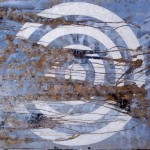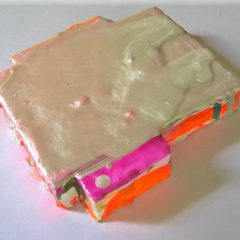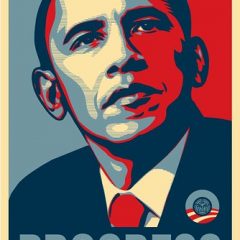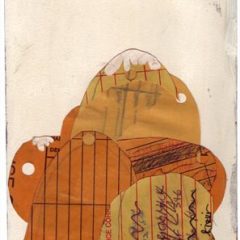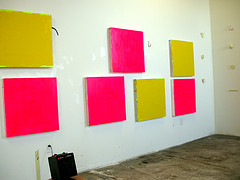
Installation shot of the artist’s studio. Click image to see it bigger.
Studio visit with John Tallman
I met John Tallman in late January at his studio in Kensington, an area that’s being studio-fied as more artists move northward in search of affordable digs. Tallman’s is one of two studios upstairs in a large red brick building on Orchard St. that might have been a factory at one time. Now it’s got an auto fixit shop on the ground floor. As we looked out the studio window facing east, Tallman pointed out several other factory-like buildings that he knows are being rehabbed for artists.
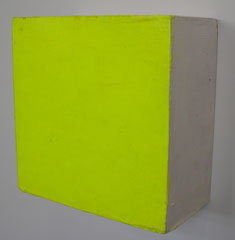
Yellowization, paint on canvas or wood
Tallman, a Tyler BFA (1991) and University of Washington MFA (1993) — both degrees are in painting — said he had been out of the country for five years teaching English and art in Korea.
For the six months he’d been back he had been working on his art and looking to get hooked in to the Philadelphia scene. In fact he was already connected on one level, having landed a solo show at Abington Art Center’s community gallery.
The artist, who worked on a mural project in Korea and also was art director and cd artist for several albums of music by the multi-national band Dabang Band, is married to a Korean woman, Kyong Hee (Connie). They have a pre-school age son, Jacob.
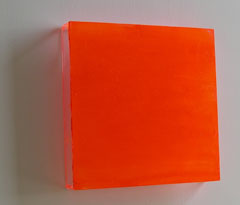
Chinbookdong, acrylic on plexiglas.
As we talked and my eyes became accustomed to the bright day glow universe I saw laid out on walls, the floor and in stacks here and there, I became more and more interested in what seemed to me an aesthetic unlike what I was used to seeing in Philadelphia, something both spare and raw; something foreign in its color sensibility, and proudly anti-art.
While I didn’t think so at the time, I now believe Tallman’s work has some affinity with Richard Tuttle and with David Goerk — only it’s Tuttle and Goerk run through an Asian blender where Buddhism merges with plastic tchotchkes and florid-colored kimonos.
“Being in Korea is an assault on the eyes,” he said when I asked about the colors, which I assumed were Asian-influenced. I don’t know anyone using these craft-store shades in such intense saturation.
Cities like Jeonju, where Tallman had been an assistant professor of English for those five years are full of bright-colored and lettered sign boards in the commercial strips the artist said. The city is densely populated and “It’s all very quick, cheap and flat,” he added, describing the Korean urban aesthetic.
“When I got there there was a cognitive dissonance. Everything was the opposite of your expectations. My work at that time was a way to process the environment The work had a vacancy to it.”
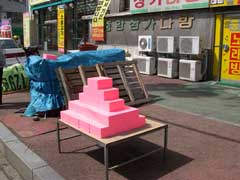
Shijang, which means market in Korean. This is the pink piece he put in the market in Jeonju.
Tallman did a guerilla piece in an outdoor market when he was there. He made some hot pink boxes and set them out in the marketplace where all the vendors were selling apples and pears. It might have been an assertion of his self into the foreign environment. Here am I, I’m like you — and not like you. I am reflecting you.
Some people didn’t get it. Others got it and appreciated his boxes as meta-strawberries.
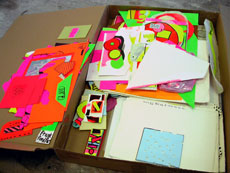
Portfolio of cut out drawings on CVS poster board.
I asked him what his earlier work was like and he said it was a little cartoony. He pulled out a large portfolio of drawings made on CVS’s finest poster board and the works, like the paintings and sculptures, felt new and exciting — cryptic, and all on paper cut in funny, odd ways, almost like stickers but not. What the drawings most reminded me of was runes, but done with a comic sensibility.
Tallman’s works are in the Drawing Center slide registry in New York and he told me he’d been up there several times since being back, showing a curator his drawings.
In a novel approach to merging his paintings and sculpture into one world, the artist has been making molds of his paintings and casting them anew in resin. He’s concerned with the 3-D-ness of his work. In fact, he’s an installation artist and his thinking is all about relationships — how this piece relates to that wall and doorway and how everything flows around the room.
In his studio, the works felt like visual, pre-verbal Morse code. The works were grouped like this: 3 circular things together here…space…pile of square things on the floor there…space…5 large squares on the wall…space…tiny cookies around a door frame, etc. The whole room was a paragraph of thoughts about relationships that build up over time.
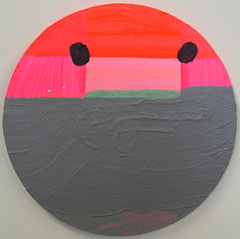
Frankford Journal. Paint on plexiglas. Notice the texture.
Tallman is quiet and intense with a nice sense of humor. His practice involves painting, sculpture and drawing. And the three medias merge and seem of a piece, unified by color and texture and the repeat of circles and squares. All the work I saw had a kind of lumpy, kitchen-art component to it. By that I don’t mean it was badly made or artsy-craftsy. The work wears its surface textures — pocks, brush strokes, drips, scrapes and finger impressions — proudly.
I asked him about the surface cragginess . “Everything you see is there,” he said. “I don’t try to wipe it out. I’m in favor of not cleaning things up.
His show at Abington is called “This Time It’s Personal.” It’s not meant as a statement that the work is personal therapy, he said. “It’s not personal narrative. It’s personal in a way I can’t really express,” said the English teacher at a loss for words. There are, however, some literally personal touches on the works, like letters and hand-made lines. So it’s kind of personal in a universally-coded way (think Jung).
“I’m attracted to minimalism — casual, hand-made minimalism,” he said. I don’t put all of my thought in one work. I take five percent of it. Each thing I do I’m trying to break it apart. ”
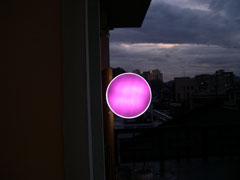
Dusk, paint on sign board mounted outside window and lighted.
In a follow up email recently Tallman said: “I really, really want the viewer to have the experience of being in MY world and I think you picked up on that. I’m very interested in artists and art that has the ability to create that experience. Which is why I’ve decided to reread Melville’s Moby-Dick, page by page. It may not be the hip thing to do but any book with chapters titled…”The Dart,” “The Crotch,” “Squid,” “The Specksynder,” “Surmises” and “Of the Less Erroneous Pictures of Whales, etc.,” …well you can’t go wrong.”
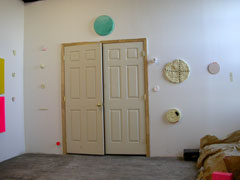
Studio doorway and walls encrusted with little jewel-like cookies cast from resin and some with hand-painted lines and dots. Very very sweet.
Tallman’s show at Abington is up only another few days. I highly recommend it as a kind of cross-cultural immersion that’s whimsical and a little wild. Tallman’s adornment of the Abington space (like what I saw in his studio) is both treasure hunt and warm gift. You need to look closely at the walls and interstices to catch it all. What it gives you back for your time spent looking is an appreciation of space and an idea about how rhythm and thought can be communicated non-verbally.
Tallman’s a risk taker. This work is not necessarily easy nor will it be everyone’s cuppa. But I love the idea behind what he’s doing — and the straight-forward connection he has with his materials. The work is about communicating and about a vision of the world that includes past, present and future; it includes art, the marketplace, the walls and doors of real space.
Foreign and exotic, the work is West by East; Philadelphia by Jeonju, and I look forward to seeing where Tallman takes his vision in the future.
See my flickr set of the studio visit and of the Abington installation.



